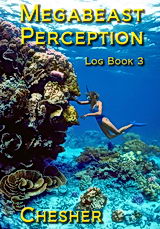Is we Is or Is We Ain't?
The Objective World
The most confusing issue of cognitive science is the objective world. Do we make up reality or interact with a separate objective world "out there". The majority of people in Western Civilization think this is a nutty question. Eastern civilizations and cognitive scientists take the issue more seriously. I've met many "new age" people who take the issue too seriously and have possibly missed the point entirely. So, anyway, maybe it's not such a goofy question and might even be useful to understanding objectivity.
Lets start with the objective world since we all seem to be faced with something that sure looks like one. An objective, real world, seems logical from the sense perception we have of separate individuals out there peering around at the world and seeing each other and other things in it. An objective world also gives rise to the notion of an observer and we all feel like we are that, at least.
But those individuals we see - and us doing the observing - are, in fact, without question, focal points of interacting forces; flows of energy through an irregular, but contiguous expanding universe.
The appearance of individuals as separate entities is illusionary, just as a waterspout (a sea going tornado) appears to be a solid vortex but is actually a flow of air and moisture in a special pattern. The flow of air does not begin and end with the waterspout, but begins with the thermal irregularities of solar radiation on the planet's atmosphere and does does not actually end anywhere.
The vortex is real and once it begins spinning. Its own behavior fosters its survival. We can identify approximate regions of a waterspout, but if we follow the movement of air we can't identify exactly where, in the atmosphere, the waterspout begins and ends.
In the same way, once a hurricane gets organized, it fosters its own survival and can stay organized even when it moves into regions where it could not have formed.
We can see the whole process - coming together, changing, expanding outward, and the impact of this process on the region outside the vortex. This impact fostering a resumption of the pattern - with an element of change that causes the waterspout or the hurricane to move from one place to another.
Since this is exactly the universal pattern of becoming, what we decide about the vortex should apply to every other kind of being in the objective world (if there is one). Here's the hard part.
We can identify a difference in "direction" between movement of air into and out of the vortex.
-
Therefore the vortex gives a polarity to the movement (to or from).
-
This is an extension of change and directionality, and comes into existence or vanishes along with, and because of, the vortex.
If we plot the velocity of a cubic centimeter of air
as it flows through the system with reference to how fast the air moves
over the surface of the sea, we see it speed up as it moves towards the vortex, reach
maximum velocity as it enters the vortex and then slow again as it leaves the system and
joins the ambient air mass.
We discover a similar pattern if we plot the angular rate of change of compass direction of any selected cubic centimeter of air as it approaches, enters, and leaves a waterspout.
The changes in direction accelerate as the sample nears the axis of the waterspout, reaches a maximum rate of change in the wall of the vortex, and then slows again as it moves away.
However, if we shift our reference to the axis of the waterspout itself and plot the movement of air from the viewpoint of the waterspout, we see a different pattern.
-
The air accelerates towards the waterspout, just as in the previous two plots.
-
When the air enters the spinning vortex it abruptly stops moving towards the central axis of the waterspout
-
Then it moves away again, very slowly at first as it winds its way up the funnel, and then more rapidly as it spreads away from the vortex in the clouds
-
Finally the air stops moving relative to the waterspout axis as the ambient air mass moves together with the overall movement of the waterspout.
We could use other measures and references
We could measure our little cube of air relative to many other referents:
-
such as change in speed or angular momentum relative to the spin of the planet,
-
the orbit of the planet around the sun,
-
or distance from the observer.
There are also other measurable conditions such as electrostatic potential, atmospheric pressure, humidity, particulate matter, and turbulence. They all would show different relationships depending on our selection of referent for measurement.
The critical point is this.
There is a shift in the relationships we observe when we base our referent on the vortex itself as opposed to some outside system. By considering the vortex as an isolated object, and using it as the referent, we observe and measure a completely new and unique set of relationships.
Now, which is the correct way to think about and measure the vortex?
Another way to think about this is to float down a river. If you float free, with the water as your referent, the water velocity is zero because you are moving with it. There is no current. If you hold onto a rock in the river, the land becomes your referent and there is a current. So is there a current or not?
Two observers could argue all day about wind speed in a waterspout (zero or 100 knots) or water current (zero or 3 knots) unless they understood their referents.
Why is this important?
So why is this an issue at all?
Because it's not always so obvious what system of reference we are using. It gets to be a problem when we can't determine what our referents are, or accurately measure what we are trying to observe. We run aground on this problem all the time, especially in cognitive science because it is a simplification of the difference in focus between things and processes.
And the answer to this, in turn, determines if there is an "Objective World Out There." With associated problems of an "inner reality" and an "outer reality."
There is (not) an objective world
Cognitive science, and public opinion fester around this sore point and currently argue two major options.
-
There is an outer reality and an inner reality. Most people are happy with this plan.
-
There is only an inner reality - no outer reality. A viewpoint with a growing number of believers.
Things get really confusing with additional overlays:
There is not only an inner and outer reality but also an entirely separate realm of the ideal. As per Plato, Aristotle, Descartes and modern Physicists like Penrose.
A spin off of 3 is; There are spiritual realities and higher dimensions. These shape what happens in the observable external and feelable internal realities. This not only includes all Judeo/Christian and Muslim belief systems but New Age philosophies and biologists like Rupert Sheldrake (Morphogenetic Fields) and Lyall Watson (Life Tide).
There are spiritual realities and higher dimensions that shape what happens in inner psychic reality but there is no objective outer reality. This would include many individuals of Group 3 plus Buddhists and related philosophies.
People feel strongly about this subject. The alternate viewpoints generate considerable controversy since they are, by nature, based on the polar issue of outer versus inner in relation to beings in general and people in particular.
Issues such as,
-
The controversy about matter, mind, and spirit.
-
The relationship between the observed and the observer,
-
Physics stress between a reality made up of particles (like quarks) or waves (string theory).
-
Social and legal arguments about the one versus the many, individual versus the community.
-
Biological controversies such as "is the earth alive" and "metamorphic fields".
-
Is we is or is we ain't has been the focus of Zen and other religious and philosophical discourse for millennia.
A processional event has no inner or outer reality.
All of these issues are basically the same paradox seen from different viewpoints, using different referents.
On the one hand, there is no doubt a waterspout is an entity and a very dangerous one at that. There is a definite inside and outside, to and from, up and down to a waterspout. I have run an 18 foot fiberglass runabout through one, so I can tell you for a fact it has an awesome windy substance when you look up it's skirts.
Our definition of the waterspout as a thing versus a process depends very much on our own position relative to the waterspout. We use terms like objective world, inner reality, higher dimensions, mind, matter, and spirit to describe various viewpoints and use presumed mental and verbal referents to make our points.
These "concepts" are human linguistic overlays on processes. They derive from human perceptual systems and biases that are, in turn, physiological processes.
There is no doubt that the waterspout is a process, a continual and complex flow of energy and air. If the waterspout is considered a flowing process, there isn't any real division between the waterspout and the atmosphere. The waterspout becomes a feature of the atmosphere - appearing and vanishing depending on the stage of the process.
It has no separate, inner reality or outer reality. Nor is there an objective world outside of it. The objective world and inner reality are verbal overlays we impose on a seamless processes.
Viewed this way, seen as a process that involves the whole atmosphere, sea, sun and us observing it, the verbal threads we cast over the scene can be whatever we feel like saying about it.
If our "inner reality" is seamless with our "outer objective reality" (which it is) then you can happily take your pick how you want to describe it to yourself and your friends. Or your opponents.
A seamless thread of observations
We can, as cognitive scientists now do, insist that the processes we observe are entirely that - observations. And there are no processes outside of our observations. This is true, in a way, since our observations are one part of a seamless flow of information extending throughout the entire system, stopping nowhere from cosmos to quark.
This observation will be welcomed by those who argue so emphatically that reality is entirely what we decide it is. My only problem is in figuring out who, exactly, gets to decide reality.
Until this is settled, we should probably avoid getting in the way of waterspouts.



